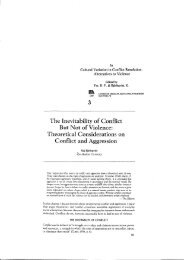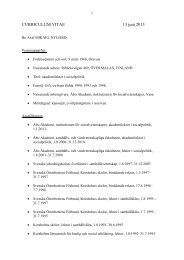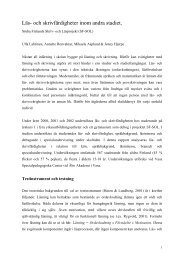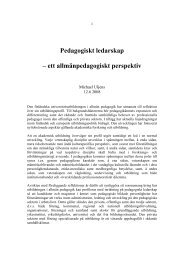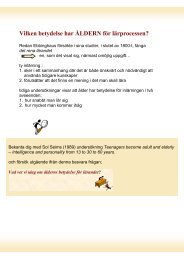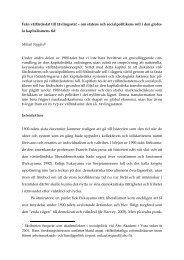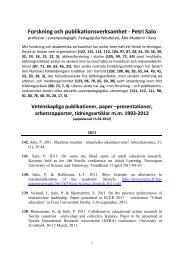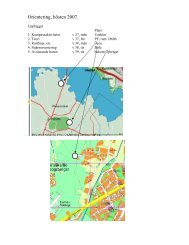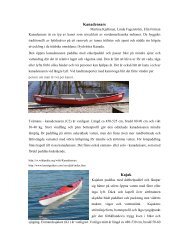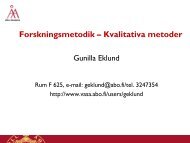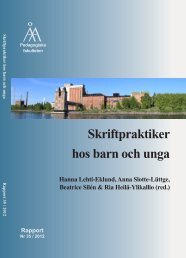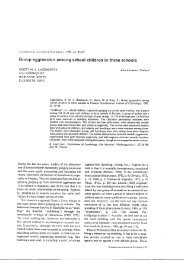Drama Boreale - Åbo Akademi
Drama Boreale - Åbo Akademi
Drama Boreale - Åbo Akademi
Create successful ePaper yourself
Turn your PDF publications into a flip-book with our unique Google optimized e-Paper software.
In the third and final phase with experiments dramaturgy was not used as specific<br />
models, but aspects of the dramaturgical models were used in two experiments.<br />
<strong>Drama</strong>turgy is rarely used according to “pure” models, but rather are different aspects of<br />
models chosen in an eclectic way. This makes the learning process more complicated to<br />
analyse, because the combination of different dramaturgies implies combination of<br />
different epistemologies and learning strategies. Two schools, two teachers and 35 pupils<br />
participated in the third phase. The research methods in use for gathering data were<br />
observation, tests and interviews.<br />
The experiments in the third phase were done in accordance with the teacher priorities<br />
within a) the syllabus in the different subjects (social studies, science and mathematics),<br />
and because of b) specific problems with the learning climate in the two classes<br />
involved.<br />
In one of the classes the teacher wanted a project about Galileo Galilei, and the teacher<br />
wanted to use dramaturgy in order to create a specific learning process. This teacher<br />
wanted a learning process that was rewarding both to both high achieving pupils (but<br />
bored of school; mostly girls), the majority of ordinary pupils, but not so bored of school<br />
(both boys and girls), and pupils that were low achieving, and bored of school (mostly<br />
boys).<br />
The second teacher wanted to create a similar learning situation in mathematics, i.e. a<br />
creative process that is not just adapted to ordinary and low achieving pupils, but that<br />
might also be rewarding to the high achieving. In the first class I as participating action<br />
reseracher created a drama about Galilei and the inquisition, according to the aims of the<br />
curriculum, using physical experiments, the convention teacher-in-role, and some more<br />
or less conventional methods. I carried out the teaching and was leading the learning<br />
process, while the teacher was observing it, and assisted with video-documentation and<br />
offered some technical support (sound effects, etc.).<br />
In the other class the teacher did all the planning, and she also carried out the teaching<br />
and supervised the learning process. I observed the experiment and documented it on<br />
video tape. The teacher wanted to examine if, or how, simultaneous dramaturgy might be<br />
composed and carried out in order to create a rewarding learning process for both high<br />
achieving and low achieving pupils. In the following paragraph I will concentrate on the<br />
Galilei experiment and a description and analysis of the third phase of the project.<br />
Before the analysis I present my theoretical framework connected to the concept<br />
dramaturgy.<br />
<strong>Drama</strong>turgy and learning<br />
<strong>Drama</strong>turgy is traditionally understood as the technique or poetics of dramatic art which<br />
formulates principles for how a drama is composed or structured. In late modernity<br />
dramaturgy is more often understood as an ‘art of telling and performing’, and may<br />
therefore be used in the composition and presentation of news, politics, teaching,<br />
demonstrations, religious ceremonies, military operations, architecture, etc. 4 All teaching<br />
and learning has an element of composition, presentation and communication. Therefore,<br />
it is meaningful to examine how the concept dramaturgy can be applied in school, and<br />
how it can contribute to improve the repertoire of teachers with a focus on teaching and<br />
learning processes. I understand dramaturgy in teaching and learning processes as a<br />
4 See Olav Njaastad’s use of the term in relation to journalism (Njaastad 2004: 172), and the article<br />
‘<strong>Drama</strong>turgy and Architecture’ in <strong>Drama</strong>turgy. A User’s Guide, London: Central School of Speech<br />
and <strong>Drama</strong><br />
97



